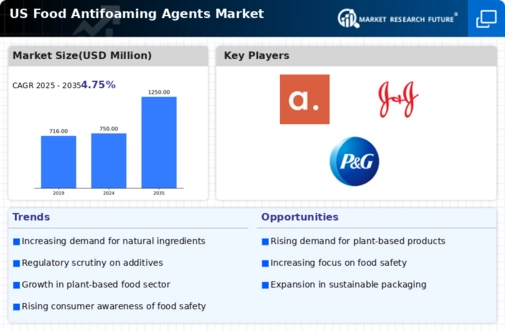The US Food Antifoaming Agents Market has become increasingly competitive as food and beverage manufacturers seek to improve product quality and shelf life while minimizing foaming issues during production processes. Antifoaming agents are essential in various applications, including dairy products, baked goods, and beverages, to ensure smooth operation and enhance the sensory attributes of the final products. The market comprises numerous players aggressively innovating and expanding their product lines to meet evolving consumer demands and regulatory requirements.
Competitive strategies within this market often include investing in research and development to create more effective and environmentally friendly formulations, along with partnerships and collaborations to expand distribution networks and market reach.
Celanese, a major player in the US Food Antifoaming Agents Market, is recognized for its robust product offerings and innovative solutions that cater specifically to the needs of the food industry. The company leverages advanced technologies to develop high-performance antifoaming agents, ensuring their products meet stringent quality standards. Celanese's strengths lie in its extensive research capabilities, enabling them to deliver tailored solutions to their customers. Their commitment to sustainability and regulatory compliance has further solidified their position in the market, allowing them to build lasting relationships with key stakeholders across the food sector.
Celanese's strong brand reputation and extensive expertise in material science enhance their competitive advantage in providing effective solutions that address the unique challenges faced by food manufacturers in the US.Parker Hannifin operates as a significant contender in the US Food Antifoaming Agents Market, focusing on delivering high-quality solutions to its clientele.
The company offers a diverse range of antifoaming products designed for various food applications, ensuring optimal performance and consistency. Parker Hannifin's strengths include a strong market presence backed by a solid reputation for reliability and efficiency within the food processing industry. Their proactive approach in research and development allows them to stay ahead of market trends and technological advancements. Furthermore, Parker Hannifin has engaged in strategic mergers and acquisitions to enhance its product portfolio and expand its operational footprint in the US. This strategy has allowed them to leverage synergies from acquired businesses and address growing customer demands effectively.
The company remains committed to upholding high standards of quality and innovation, positioning itself as a preferred choice among food manufacturers navigating the complexities of formulation processes.













